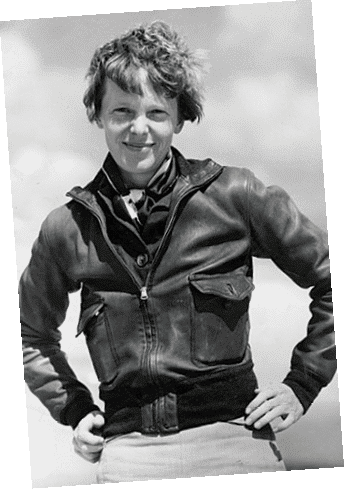
Hoosier Hall of Fame: Purdue’s Giant Leaps
This story is part of Indianapolis Monthly’s 2016 Indiana Bicentennial coverage, which includes our list of the 200 Hoosier Hall of Fame picks, designated throughout in bold or highlighted. For more on this celebration of the state’s first two centuries, click here.
The Amelia Earhart timeline.
The Pearl Harbor timeline.
The Gus Grissom timeline.
The Neil Armstrong timeline.
The David Wolf timeline.
1909
J. Clifford Turpin, a young engineer and Purdue grad, begins working for Orville and Wilbur Wright
Turpin helps them improve their fledgling flying machine’s engine and gets aviating lessons from Orville, becoming the first Purdue alum to take to the air.
1910
Mechanical-engineering professor Cicero Bailey Veal launches Purdue Aero Club
Caught up in the school’s growing enthusiasm for flying, Veal presents lectures such as “Aviation Problems of the Past, Present, and Future.”
1919
Alum George Haskins lands an airplane on campus
After touching down, Haskins delivers a resolution from Purdue’s Dayton, Ohio, alumni group proposing a School of Aviation Engineering. He will become one of the school’s first aeronautical-engineering professors.
1930
Purdue becomes first U.S. university to offer college credit for flight training
The move is controversial among faculty but championed by President Edward C. Elliott.
1935
Elliott hires Amelia Earhart
Earhart acts as career counselor for women until her 1937 disappearance. On campus, she visits early aeronautical-engineering classes.
1941
During the attack on Pearl Harbor, former Purdue student George Welch and fellow pilot Kenneth Taylor shoot down the most Japanese planes
Welch’s heroics help establish Purdue as an important aviation-training ground for the U.S. military.
2001
Pearl Harbor debuts in theaters
Many critics believe the two lead characters—played by Ben Affleck and Josh Hartnett—are based on Purdue’s Welch and another U.S. pilot.
1945
Purdue’s first school of aeronautical engineering opens
1946
Virgil “Gus” Grissom enrolls at Purdue
The Mitchell native, also a WWII vet, earns a mechanical-engineering degree, and then flies for the Air Force in the Korean War.
1961
Grissom travels in space, the second American to do so
An original Project Mercury astronaut, he barely escapes from his Liberty Bell 7 craft after an apparent malfunction causes it to sink in the ocean. (In 1967, Grissom will command the Apollo 1 test launch, in which he and two others become the first Americans killed in pursuit of space travel.)
1979
Publication of Tom Wolfe’s The Right Stuff
Grissom’s Liberty Bell 7 accident provides dramatic conflict in Wolfe’s bestselling account of the Mercury missions and the Oscar-nominated 1983 movie.
1955
Neil Armstrong graduates from Purdue’s school of aeronautical engineering
He will later be selected for the U.S. Air Force Man in Space Soonest program.
1969
Armstrong is the first man to walk on the moon
Before returning to earth, he leaves a patch from Grissom’s fatal Apollo 1 mission behind.
1990
Indy native and Purdue electrical engineering grad David Wolf enters the NASA astronaut program
1993
NASA shuttle Columbia takes flight on mission STS-58
Including Wolf and fellow Purdue alum John Blaha, STS-58 is considered perhaps the most successful space-laboratory mission ever, conducting critical research into the effects of space on human physiology. Wolf will go on to enjoy space walks and stints on the International Space Station.
2016
Purdue claims the third-highest number of astronaut alumni—23—among non-military institutions






